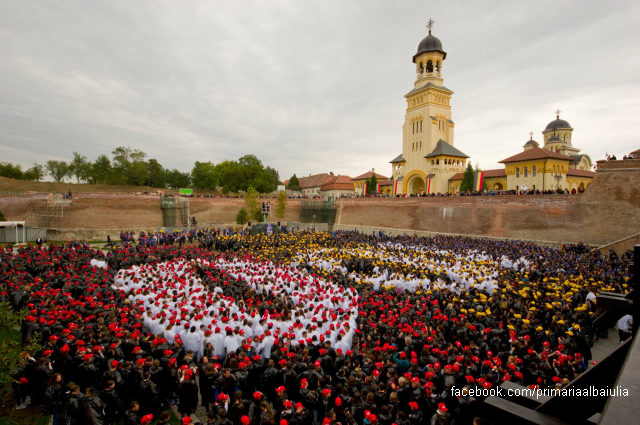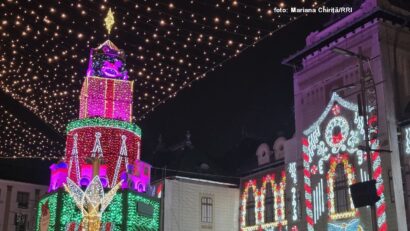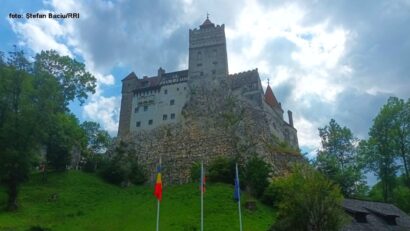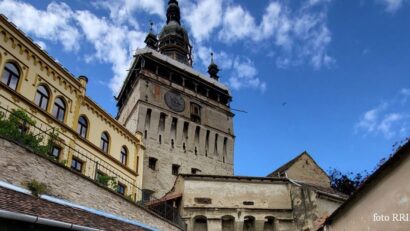The Union Museum in Alba Iulia
A virtual tour of the Alba Iulia Union Museum and Citadel

România Internațional, 16.04.2020, 12:24
Alba Iulia is particularly known to the general public and specialists for its age and for the significance of the historical events that occurred there. One of the institutions in Romania that are now trying to accommodate virtual tourists is the National Union Museum in Alba Iulia. So, in todays edition of our travel show we will take a virtual tour of both the museum and the citadel, accompanied by the museums general manager Gabriel Tiberiu Rustoiu.
Lets therefore step into the citadel of Alba Iulia, which comprises seven bastions, which are a good illustration of all fortification techniques used back then. The entrance is secured through six gates, most of them decorated with statues and reliefs. Gabriel Rustoiu will next tell us a few things about the rich history of the place, starting with the medieval times:
“In the Roman times, Alba Iulia was once the capital of Roman Dacia. We can find here traces of the only Roman Legion that stayed during the entire period of Roman rule in Dacia, the XIII Legion Gemina. It left behind a castrum, on top of which the medieval fortress was later built. Also, here there are two Roman towns which were upgraded to the status of colonia, and this is a unique situation in Romania. Starting with the 12th century, that was the richest town in Dacia, as it was the place where Dacias treasures were collected to be further sent to Rome. In fact, we have found a 3rd century inscription in which Apulum is described as Crisopolis, which means the Golden Citadel, because the place was extremely rich back then. Thats one reason why those who love artifacts should come to Alba Iulia.”
Part of the castrum has been restored, Gabriel Rustoiu told us:
“We have the main gate, Principalis Dextra, which can be seen. We also have part of Via Principalis and also a part of Principia Castrum, now restored and accessible to all tourists. Of course, our museum remains home to the most important artifacts from Apulum, but also from Dacia. Then, in the Middle Ages, for a brief period of time, Alba Iulia was the capital of the Transylvanian Voivodeship and then of the Principality of Transylvania. In the citadel of Alba Iulia, we can see the Roman-Catholic church, whose patron saint is St. Michael. This is the most representative medieval architecture monument in Transylvania. Visitors can admire here the oldest Roman sculptural element in Romania, the oldest Renaissance construction in Romania. Actually, this cathedral is a full course into Transylvanian medieval architecture. The tombs of the Transylvanian princes are inside the cathedral.”
Alba Iulia is definitely an extremely important city for all Romanians, as it is the place where Romanias modern history started, the general manager of the Union Museum Gabriel Tiberiu Rustoiu told us, giving us a tour of the place, starting with the Union Hall:
“This is the hall where, on December 1st, 1918, the representatives of all localities in Transylvania decided to unite with Romania. The Union Hall is extremely important to our museum. Here one can see a number of items and artifacts that defined the December 1st event. Another important building is the Babylon facility, which used to host the Austrian garrison in Alba Iulia. Now the place is hosting the History Museum, where we have exhibited items from times immemorial until WWII. We are proud to say we have several artifacts that are quite unique in Romania and in the world. Besides this building, we also have the Museikon, which is devoted to sacred art. This museum is quite unique in Romania, too, due to both the items on display and the way in which they are presented. We have rare icons and old books. Out of the books on display, only a tiny few can be found elsewhere in the world. During that period, Alba Iulia was the capital of Transylvania, and the Transylvanian princes would set the tone for politics in this part of Europe. One such prince, for instance, Stephen Bathory, became the king of Poland. Also, the armies of Gabriel Bethlen would march to Vienna.”
The museum has some 200,000 heritage items, and the library is home to some 70 thousand volume, Gabriel Rustoiu told us:
“We have a number of exhibitions that illustrate Romanias history through archaeological pieces, but also temporary exhibitions devoted to the Great Union. Our posters are in both Romanian and English and we also have guides that speak English and French. A few years back we also employed a sociologist and weve conducted sociological studies for eight years now. Therefore, weve collected reactions from both Romanian and foreign tourists. In general, from what weve seen, the attitude is predominantly a positive one. We also have a Facebook page where we get scores from our visitors, and they are generally very high.”
Unfortunately, these days we cannot visit the museum as such, but a solution has been found for those who want to visit it virtually, through an augmented reality application available on smart phones. The Alba Iulia National Union Museum and the December 1st University of Alba Iulia have archived in the application called Cultura Transilvanica works from the museums gallery that are representative for Transylvanian culture. Its an archive of 3D iconic works of art found in the most representative museum collections in Transylvania. Each artifact is accompanied by a brief description of its origins, so the virtual visitor can learn more about Transylvanias cultural treasures. Also, one can check the Online Catalog of the Alba Iulia National Union Museums library. Moreover, on the museums page there is a link that takes one to the project ARHEO 3D. Here visitors can watch a large number of items from prehistory, from the Dacian, medieval and modern periods, in 3D. (M.Ignatescu)






























